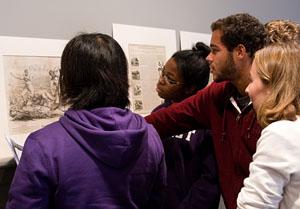November 11, 2010
Contact: Karen Cardinal
Accounting, Web and Marketing Manager, Mead Art Museum
413/542-2551
AMHERST, Mass.—The Mead Art Museum of Amherst College has announced an exciting collections-sharing initiative with the American Antiquarian Society (AAS) in Worcester, Mass., one of the nation’s premier collections of American historical documents. Throughout the fall term, a dozen 19th-century political broadsides, cartoons and prints on loan from the AAS will be available to students and faculty in order to expand their study of politics and race. A team consisting of Hilary Moss, assistant professor of black studies and history; Randall Griffey, curator of American Art; Pamela Russell, Andrew W. Mellon Coordinator of College Programs; and Lauren Hewes, AAS Andrew W. Mellon Curator of Graphic Arts, chose these objects for use in Moss’s first-year seminar, “Slavery and the American Imagination.” Addressing issues of race relations, slavery and politics before and during the Civil War, the objects from AAS serve as engaging catalysts for classroom discussion and student research.
 Moss (far right) and Amherst students studying broadsides from the collection of the American Antiquarian Society on Oct. 7. Photo by JLM. |
“Works of original art and visual culture make history tangible,” said Moss. “My students have benefitted immeasurably by their exposure to the Mead’s and the American Antiquarian Society’s resources and by this institutional partnership.”
Jensen Bouzi, Caitlin Britos and Robert Cahill, all members of Amherst’s Class of 2014, were hard at work one recent afternoon in the Mead study room interpreting images for a class assignment. Britos noted how much easier is was to examine a document directly than viewing it in an online image. “You can see every detail and make out the texts so much better,” she said. Cahill was studying an unsettling image of an affluent white child whipping a black doll, sarcastically titled “The Early Development of Southern Chivalry.” With his laptop at his side, he was researching childhood on southern plantations and making connections with literary works they had read in class. Bouzi was excited to be working with an original work of art for the first time, something he never imagined he’d be doing within his first two months at college. “This makes you think outside the box,” he said, “and once you do, you can bring that approach to other projects. This is the real deal.”
Georgia Barnhill, director of the Center for Historic American Visual Culture (CHAViC) at the AAS, believes collaborations such as these allow archival resources to play a vital role in new investigations into America’s history. “One of [our] goals is to introduce students and their professors to visual materials as documents rich in research potential,” said Barnhill. “CHAViC does this through conferences and seminars at AAS. Another strategy, however, is to loan materials to a college art museum or library to enable the students to interact with the visual materials in a structured and meaningful way. We are delighted to play a role in the education of the next generation of historians.”
“We’re thrilled to augment the Mead’s distinguished holdings of fine art with these fascinating visual materials drawn from the American Antiquarian Society’s rich and deep collections,” said Elizabeth Barker, director and chief curator at the Mead. “Our museum’s mission is to integrate the visual arts into the academic life of the college: these treasures from the AAS enhance our students’ ability to work with original documents and encourage them to think creatively about enduring issues of propaganda, bias, and the dissemination of ideas.”
The American Antiquarian Society is a learned society and research library founded in Worcester, Massachusetts, in 1812 by Isaiah Thomas, a patriot leader during the American Revolution and the foremost printer, publisher and bookseller in the United States following Benjamin Franklin’s retirement from the trade. AAS is the third oldest historical society in the country and the first to pursue its scholarly activities on a national level. The Society maintains a research library containing the largest collection in the world of American imprints issued through 1820 and one of the largest collections of such material published from 1821 to 1876. The collection rivals, and in some areas surpasses, those of the Library of Congress, Harvard University, and the New York Public Library.
The Mead Art Museum houses the art collection of Amherst College, totaling more than 16,000 works. An accredited member of the American Association of Museums, the Mead participates in Museums10, a regional cultural collaboration. During the academic term, the museum is open Tuesday through Thursday and Sunday from 9 a.m. to midnight and from 9 a.m. to 5 p.m. Friday and Saturday. For more information, please visit the museum’s website, www.amherst.edu/museums/mead, or call 413/542-2335.
###